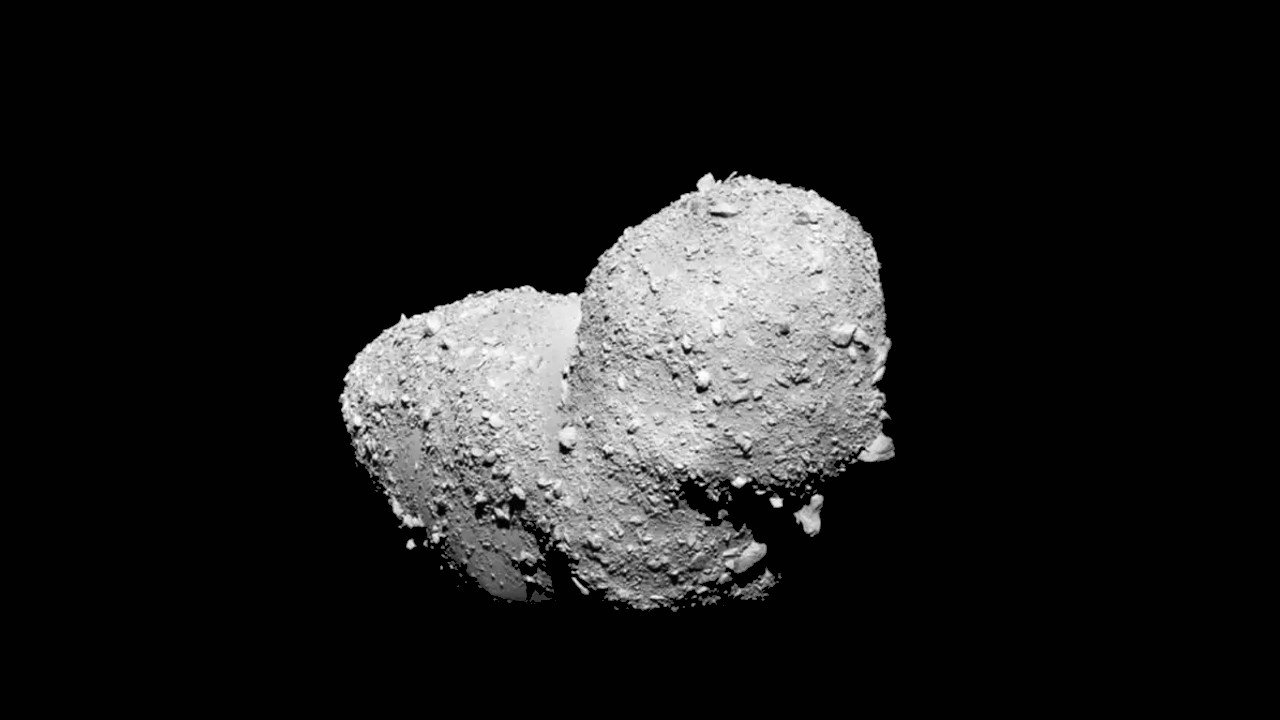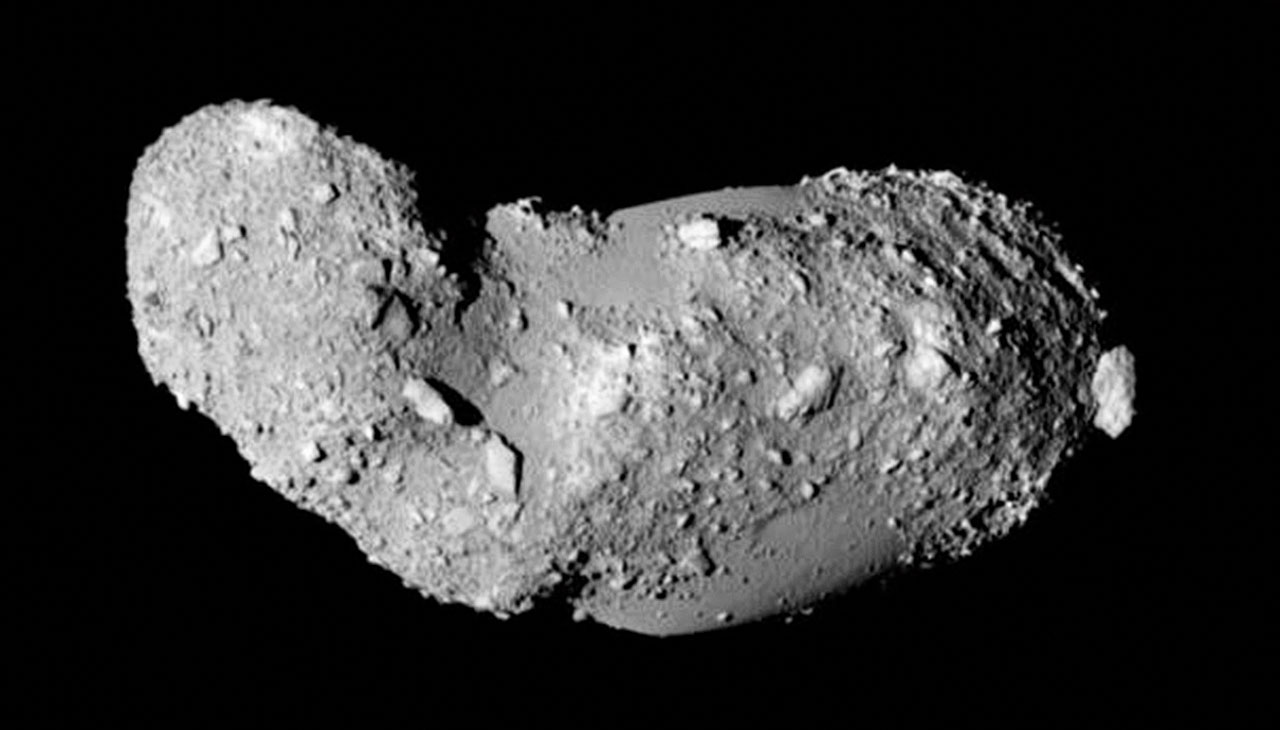Salty 'peanut' asteroid may reveal where Earth got its water
Tiny salt grains discovered in samples returned by the Hayabusa mission imply liquid water could be common in the largest solar system space rock population.

An infamous "space peanut" is fittingly salty: Tiny salt crystals have been found in a peanut-shaped asteroid, implying that the largest body of space rocks in the solar system may be richer in water than astronomers thought.
The sodium chloride crystals, which only could have formed in the presence of water, were discovered in the sample of asteroid Itokawa that was returned to Earth by Japan's Hayabusa mission back in 2010.
Scientists have long theorized that asteroids were one of the primary delivery methods of water, a vital ingredient for life, to our planet in its infancy. The team behind the discovery of the salt crystals said the find is interesting because Itokawa is an "S-type" asteroid , a type of space rock previously hypothesized to lack hydrated or water-bearing minerals. The finding suggests that a large group of asteroids orbiting the sun aren't as dry as scientists thought and that most, if not all, of Earth's water arrived via asteroid bombardment during the planet's violent early history.
Related: Water found in tiny dust particles from asteroid Itokawa
"The grains look exactly like what you would see if you took table salt at home and placed it under an electron microscope," Tom Zega, a professor of planetary sciences at the University of Arizona's Lunar and Planetary Laboratory and senior author of a new paper describing the discovery, said in a statement. "They're these nice, square crystals. It was funny, too, because we had many spirited group meeting conversations about them because it was just so unreal."
The team made the discovery by analyzing an Itokawa sample less than twice the width of a human hair collected by Hayabusa in 2005. From this tiny piece of space rock, the team extracted an even smaller sample about the size of a yeast cell.
It is the first time researchers have confirmed the presence of salt crystals that originated on the parent body of Itokawa and ruled out the possibility that they are the result of contamination, a problem that has plagued previous studies claiming to have found salt in meteorites of similar origins. By comparing before-and-after images of the sample, the team determined that the asteroid was unchanged during its time in storage, thereby ruling out the chance that it acquired the salt during this time.
Breaking space news, the latest updates on rocket launches, skywatching events and more!
"The terrestrial samples did not contain any sodium chloride, so that convinced us the salt in our sample is native to the asteroid Itokawa," said Shaofan Che, a postdoctoral fellow at the Lunar and Planetary Laboratory and lead author of the study. "We ruled out every possible source of contamination."
Water, water everywhere …
Samples from Itokawa are representative of a type of space rock called "ordinary chondrites," which come from S-type asteroids such as Itokawa. Ordinary chondrites make up almost 90% of meteorites discovered on Earth, but it is rare to find water-bearing minerals within them.
"It has long been thought that ordinary chondrites are an unlikely source of water on Earth," Zega said. "Our discovery of sodium chloride tells us this asteroid population could harbor much more water than we thought."
Most scientists agree that the solar nebula — the disk of gas and dust that surrounded the sun around 4.5 billion years ago, when the solar system planets were born — was too warm for Earth to contain water vapor that could condense from gas.
'In other words, the water here on Earth had to be delivered from the outer reaches of the solar nebula, where temperatures were much colder and allowed water to exist, most likely in the form of ice," Che said. "The most likely scenario is that comets or another type of asteroid known as C-type asteroids, which resided farther out in the solar nebula, migrated inward and delivered their watery cargo by impacting the young Earth."
The presence of water in this other family of asteroids via ordinary chondrites means that Earth might have gotten its water from much closer to the sun than previously thought.
"You need a large enough rock to survive entry and deliver that water," Zega said. "If it now turns out that the most common asteroids may be much 'wetter' than we thought, that will make the water delivery hypothesis by asteroids even more plausible."
Did Itokawa have a water parent?
Itokawa, which is about 2,000 feet long and 750 feet wide (610 by 229 meters), is thought to have broken off of a much larger parent body, and the team thinks frozen water and frozen hydrogen chloride may have accumulated in that object. The naturally occurring decay of radioactive elements in Itokawa's parent asteroid and frequent bombardment by meteors during the solar system's violent early era could have supplied enough heat to sustain hydrothermal processes involving liquid water, the researchers said.
"Once these ingredients come together to form asteroids, there is a potential for liquid water to form," Zega said. "And once you have liquids form, you can think of them as occupying cavities in the asteroid and potentially do water chemistry."
This bombardment would eventually break this larger body into smaller fragments, thus creating Itokawa, the team said.
The scientists found a sodium-rich silicate mineral called plagioclase in the sample, suggesting that the salt crystal within Itokawa has been present since the early days of the solar system, when it was part of a larger body.
"When we see such alteration veins in terrestrial samples, we know they formed by aqueous alteration, which means it must involve water," Che said. "The fact that we see that texture associated with sodium and chlorine is another strong piece of evidence that this happened on the asteroid as water was coursing through this sodium-bearing silicate."
The research is described in a paper published June 12 in the journal Nature Astronomy.

Robert Lea is a science journalist in the U.K. whose articles have been published in Physics World, New Scientist, Astronomy Magazine, All About Space, Newsweek and ZME Science. He also writes about science communication for Elsevier and the European Journal of Physics. Rob holds a bachelor of science degree in physics and astronomy from the U.K.’s Open University. Follow him on Twitter @sciencef1rst.

